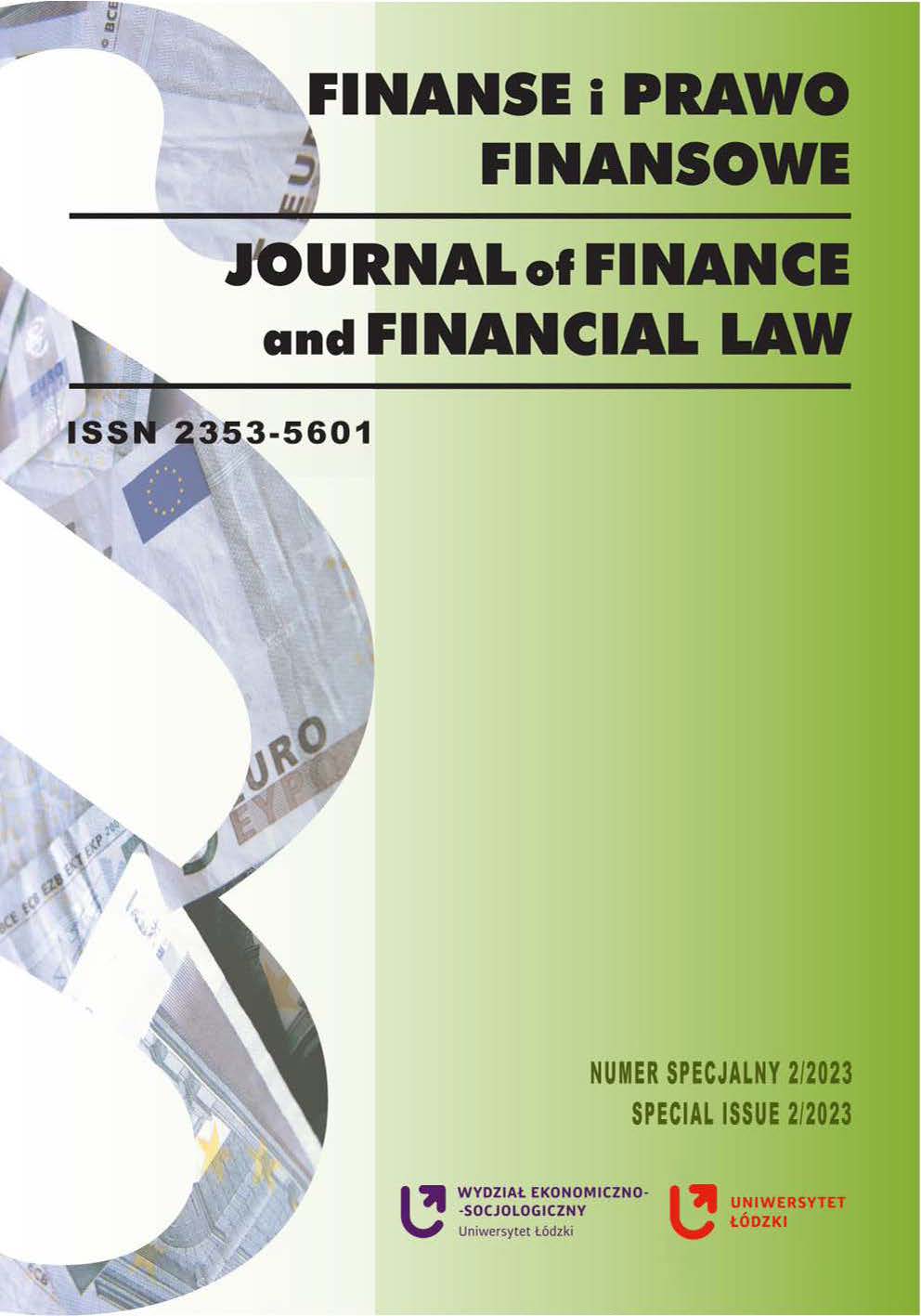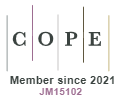Financialization of Agricultural Land – Contemporary Manifestations of Financialization or Return to the Roots of Humanity (?)
DOI:
https://doi.org/10.18778/2391-6478.S2.2023.04Keywords:
financialisation, financial markets, finance methodology, landAbstract
The purpose of the article/hypothesis. Purpose of the article/hypothesis: The aim of the research is (1) to verify the view that the purchase of land – in particular agricultural land – can be classified as a phenomenon of financing the economy; (2) expanding the definition of financialization, indicating that the dominance of finance is shifting from financial markets and institutions to the land market.
Methodology. The study was based on a hypothetico-deductive model. Deductive methods and methods of formulating and verification of theorems were used. They were carried out in the form of reflections on the science of finance on a macro, meso and micro scale.
Results of the research. The number, scope and scale of shocks that humanity has faced in the last two decades have no point of reference. Starting with the crash on the American real estate market, through the global economic and climate crisis, pandemic, and ending with numerous armed conflicts. Each of these phenomena has occurred many times in the history of humanity, but never together in such a short space of time. The multitude of discoveries causing an increasingly faster flow of information (including financial information in particular) begins to make their reception and interpretation difficult, thus causing chaos and a sense of loss for the investor (both those with a large and small capital portfolio). For this reason, some investors are moving away from investing in shares and this method of increasing wealth to committing capital to long-term and lower-risk transactions, such as agricultural land. Land has specific features such as non-moveability, non-reproducibility and indestructibility (the last feature is debatable and concerns the proper use of agricultural land) and thus appears as an investment resistant to inflation and crisis phenomena of short and medium term.
Research contribution. The current definition of financialization is too narrow. With the increase in the scale and pace of creation of financial instruments, the faster flow of financial information and the increase in the substantive scope and complexity of regulations regulating financial transactions, the financialization of the economy should be expanded to include the involvement of capital in land – in particular, but not only – agricultural land.
Limitations. The research was conducted on a limited number of literature items and requires further in-depth research. They mainly concern the markets of the European Union, North America and partly Australia. Therefore, they do not allow for the generalization of the proposed approach to financialization. It is expected that similar relationships occur in rapidly developing countries that are increasing their wealth and that of their citizens. However, this view requires verification.
Downloads
References
Beingessne, N., Magnan, A. and Wendimu, M. (2023). “Land imaginaries” in Western Canada: (Financial neoliberalism, agrarianism, and the contemporary politics of agricultural land. Politics and Space, vol. 41(4), pp. 637–655, https://doi.org/10.1177/23996544221144168
Google Scholar
DOI: https://doi.org/10.1177/23996544221144168
Clapp, J. (2014). Financialization, distance and global food politics. The Journal of Peasant Studies, vol. 41(5), pp. 797–814, https://doi.org/10.1080/03066150.2013.875536
Google Scholar
DOI: https://doi.org/10.1080/03066150.2013.875536
Clapp, J., Isakson, S.R. and Visser, O. (2017). The complex dynamics of agriculture as a financial asset: introduction to symposium. Agric Hum Values, vol. 34, pp. 179–183, https://doi.org/10.1007/s10460-016-9682-7
Google Scholar
DOI: https://doi.org/10.1007/s10460-016-9682-7
Debinski, P. (2023). Prezentacja z wystąpienia podczas sesji plenarnej na Konferencji Katedr Finansów. Poznań.
Google Scholar
Deininger, K., Byerlee, D., Lindsay, J., Norton, A., Selod, H. and Stickler, M. (2011). Rising Global Interest in Farmland: Can it Yield Sustainable and Equitable Benefits? World Bank, http://hdl.handle.net/10986/2263 License: CC BY 3.0 IGO.
Google Scholar
DOI: https://doi.org/10.1596/978-0-8213-8591-3
Desmarais, A.A., Qualman, D., Magna, A. and Wiebe, N. (2017). Investor ownership or social investment? Changing farmland, ownership in Saskatchewan, Canada. Agric Hum Values, vol. 34, pp. 149–166, https://doi.org/10.1007/s10460-016-9704-5
Google Scholar
DOI: https://doi.org/10.1007/s10460-016-9704-5
Drejerska, N. (2018). Przemiany sektorowej struktury zatrudnienia ludności wiejskiej. Warszawa: Wydawnictwo SGGW.
Google Scholar
Fairbairn, M. (2014). ‘Like gold with yield’: evolving intersections between farmland and finance. The Journal of Peasant Studies, vol. 41(5), pp. 777–795, https://doi.org/10.1080/03066150.2013.873977
Google Scholar
DOI: https://doi.org/10.1080/03066150.2013.873977
Franc-Dąbrowska, J. (2019). Crawling financialization in Central and Eastern Europe using the example of Agriculture. Economia Agro-Alimentare, vol. 21(3), pp. 677–696, https://doi.org./10.3280/ECAG2019-003006
Google Scholar
DOI: https://doi.org/10.3280/ECAG2019-003006
Garcia-Arias, J., Cibils, A., Costantino, A., Fernandes, V.B. and Fernández-Huerga, E. (2021). Meets Finance in Latin America: Some Intersections between Financialization and Land Grabbing in Argentina and Brazil. Sustainability, vol. 13, pp. 1–37, https://doi.org/10.3390/su13148084.
Google Scholar
DOI: https://doi.org/10.3390/su13148084
Gołębiowski, G. and Szczepankowski, P. (2015). Finansyzacja gospodarki krajów Europy Środkowo-Wschodniej. Ruch Prawniczy, Ekonomiczny i Socjologiczny, vol. 4, pp. 197–215.
Google Scholar
DOI: https://doi.org/10.14746/rpeis.2015.77.4.16
Langford, A., Smith, K. and Lawrence, G. (2020). Financialising governance? State actor engagement with private finance for rural development in the Northern Territory of Australia. Research Globalization, vol. 2, pp. 1–9, http://dx.doi.org/10.1016/j.resglo.2020.100026
Google Scholar
DOI: https://doi.org/10.1016/j.resglo.2020.100026
Larder, N., Sippel, S.R. and Lawrence, G. (2015). Finance Capital, Food Security Narratives and Australian Agricultural Land. Journal of Agrarian Change, vol. 15(4), pp. 592–603, https://doi.org/10.1111/joac.12108
Google Scholar
DOI: https://doi.org/10.1111/joac.12108
Magnan, A. (2012). New avenues of farm corporatization in the prairie grains sector: farm family entrepreneurs and the case of One Earth Farms. Agric Hum Values, vol. 29, pp. 161–175, https://doi.org/10.1007/s10460-011-9327-9
Google Scholar
DOI: https://doi.org/10.1007/s10460-011-9327-9
Mączyńska, E. i Pysz, P. (2013). Liberalizm – neoliberalizm – ordoliberalizm. W: Ekonomia dla przyszłości. Odkrywać naturę i przyczyny zjawisk gospodarczych. Warszawa: „Polskie Towarzystwo Ekonomiczne”, 28–29 listopada, s. 85–105.
Google Scholar
Minsky, H.P. (1992). The Financial Instability Hypothesis. The Jerome Levy Economics Institute of Bard College, Working Paper, no. 74, pp. 1–10.
Google Scholar
Oliveira, G.L.T. de, McKay, B.M. and Liu, J. (2021). Beyond land grabs: new insights on land struggles and global agrarian change. Globalizations, vol. 18(3), pp. 321–338, https://doi.org/10.1080/14747731.2020.1843842
Google Scholar
DOI: https://doi.org/10.1080/14747731.2020.1843842
Ouma, S. (2020). This can(’t) be an asset class: The world of money management, “society”, and the contested morality of farmland investments. Economy and Space, vol. 52(1), pp. 66–87.
Google Scholar
DOI: https://doi.org/10.1177/0308518X18790051
Patel, R. (2013). The Long Green Revolution. The Journal of Peasant Studies, vol. 40(1), pp. 1–63, https://doi.org/10.1080/03066150.2012.719224
Google Scholar
DOI: https://doi.org/10.1080/03066150.2012.719224
Rasva, M. and Jürgenson, E. (2022). Europe’s Large-Scale Land Acquisitions and Bibliometric Analysis. Agriculture, vol. 12(6), 850, pp. 1–13, https://doi.org/10.3390/agriculture12060850
Google Scholar
DOI: https://doi.org/10.3390/agriculture12060850
Ratajczak, M. (2013). Ekonomia i edukacja ekonomiczna w dobie finansyzacji. W: Ekonomia dla przyszłości. Odkrywać naturę i przyczyny zjawisk gospodarczych. Sesja plenarna fundamentalne problemy w teorii ekonomii i praktyce gospodarczej. Warszawa: Polskie Towarzystwo Ekonomiczne.
Google Scholar
Ratajczak, M. (2017). Finansjalizacja gospodarki: wymiary dyskusji. Bezpieczny Bank, vol. 3(68), s. 7–22, https://doi.org/10.26354/bb.2.3.68.2017
Google Scholar
Sippel, S.R. and Dolinga M. (2023). Constructing agri-food for finance: startups, venture capital and food future imaginaries. Agriculture and Human Values, vol. 40, pp. 475–488, https://doi.org/10.1007/s10460-022-10383-6
Google Scholar
DOI: https://doi.org/10.1007/s10460-022-10383-6
Sippel, S.R., Larder, N. and Lawrence, G. (2017). Grounding the financialization of farmland: perspectives on financial actors as new land owners in rural Australia. Agric Hum Values, vol. 34, pp. 251–265, https://doi.org/10.1007/s10460-016-9707-2
Google Scholar
DOI: https://doi.org/10.1007/s10460-016-9707-2
Wilkin, J. (2007). Uwarunkowania rozwoju polskiego rolnictwa w kontekście europejskim i globalnym. Implikacje teoretyczne i praktyczne, materiały na VIII Kongres Ekonomistów Polskich, www.pte.pl z dn. 25.01.2010 r.
Google Scholar
[https:1] GRAIN (2021). The state of the global farmland grab, according to the Land Matrix, https://grain.org/en/article/6758-the-state-of-the-global-farmland-grab-according-to-the-land-matrix [dostęp 08.09.2023].
Google Scholar
[https:2] https://grain.org/en/pages/organisation_ [dostęp 30.09.2023].
Google Scholar
[https:3] https://zpe.gov.pl/a/degradacja-gleb-na-swiecie-i-jej-skutki/DuguSPvVG [dostęp 05.09.2023].
Google Scholar
Downloads
Published
How to Cite
Issue
Section
License

This work is licensed under a Creative Commons Attribution-NonCommercial-NoDerivatives 4.0 International License.














